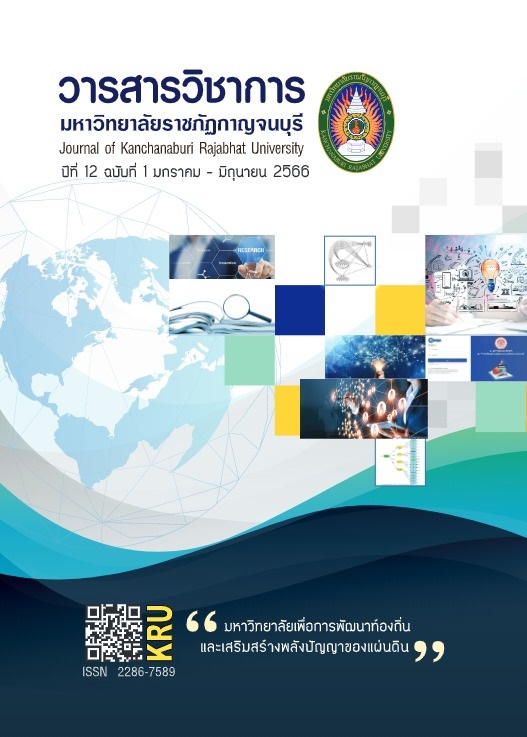RELATIONSHIP BETWEEN ATTITUDE AND STRESS OF ONLINE LEARNING OF THE INTERNATIONAL SCHOOL OF TOURISM STUDENTS
Main Article Content
Abstract
This research aimed to investigate students’ attitudes towards online teaching, stress of online learning, and the relationship between attitudes towards online teaching and stress from online learning. The samples were 194 students, selected by the purposive selection technique. A questionnaire was deployed to collect the data. The descriptive statistics employed were mean, percentage, frequency, and standard deviation; while the inferential statistics employed was the Pearson’s product-moment correlation coefficient. The findings revealed that the students had a positive attitude towards online teaching ( = 4.01, S.D. = 0.72). The students’ stress of online learning was at a moderate level (
= 3.49, S.D. = 0.90). There was a low negative correlation between attitudes towards online learning and the stress of online learning (r = -.196, p < .01). Instructors and advisors should pay attention, observe and monitor students who may be at risk or experiencing serious mental health problems in order to help and give advice to those students who are in trouble in a timely manner.
Article Details

This work is licensed under a Creative Commons Attribution-NonCommercial-NoDerivatives 4.0 International License.
References
ชฎาภา ประเสริฐทรง จรินวรรณ แสงหิรัญรัตนา และพรชนา กลัดแก้ว. (2564). ปัจจัยที่มีความสัมพันธ์กับความเครียด
ในการเรียนออนไลน์ จากสถานการณ์โควิด - 19 ของนักศึกษาพยาบาล. วารสารสถาบันจิตเวชศาสตร์ สมเด็จเจ้าพระยา, 15(1), 14-28.
ทรงศักดิ์ ภูสีอ่อน. (2552). การประยุกต์ใช้ SPSS วิเคราะห์ข้อมูลงานวิจัย (พิมพ์ครั้งที่ 3). มหาสารคาม: มหาวิทยาลัยมหาสารคาม.
ธรรมรัตน์ แซ่ตัน โภไคย เฮ่าบุญ โสภณ จันทร์ทิพย์ ธงชัย สุธีรศักดิ์ และวัชรวดี ลิ่มสกุล. (2564). ความพร้อมต่อการเรียนการสอนแบบออนไลน์ของนักศึกษา ภายใต้สถานการณ์การระบาดไวรัส COVID - 19 : กรณีศึกษา มหาวิทยาลัยสงขลานครินทร์ วิทยาเขตภูเก็ต. วารสารสังคมวิจัยและพัฒนา, 3(1), 23-37.
ฟีรดาวซ์ มูหะมัด รอฮานี เต๊ะซา และรอฮานี มาแจ. (2564). ศึกษาสภาพปัญหาการจัดการเรียนการสอนรายวิชา การใช้ภาษามลายูในชีวิตประจำวัน
รหัสวิชา (11 - 034 - 104) ของนักศึกษา มหาวิทยาลัยนราธิวาส
ราชนครินทร์. วารสารมหาวิทยาลัยนราธิวาสราชนครินทร์ สาขามนุษยศาสตร์และสังคมศาสตร์, 8(2), 137-216.
นิศากร โพธิมาศ สุนทรีภรณ์ มีพริ้ง และมาลินี อยู่ใจเย็น. (2564). ความสัมพันธ์ระหว่างความเครียดในการเรียนออนไลน์ ความยืดหยุ่นทางอารมณ์และการเผชิญความเครียดของนิสิตพยาบาล ในช่วงการแพร่ระบาด ของโควิด - 19. วารสารวิจัยสุขภาพและการพยาบาล, 37(3), 142-154.
บุญทิพย์ สิริธรังศรี. (2563). การจัดการเรียนการสอนออนไลน์สู่กรอบมาตรฐานวิชาชีพการสอน และสนับสนุนการเรียนรู้ ระดับอุดมศึกษา. วารสารวิชาการราชวิทยาลัยจุฬาภรณ์, 2(3), 1-17.
มนธิชา ทองหัตถา. (2564). การจัดการเรียนรู้แบบออนไลน์ ในสถานการณ์การแพร่ระบาดของโรคติดเชื้อไวรัสโคโรนา 2019 (COVID - 19) ของครูกลุ่มสาระการเรียนรู้ภาษาต่างประเทศ โรงเรียนปากพนัง จังหวัดนครศรีธรรมราช. วารสารลวะศรี มหาวิทยาลัยราชภัฏเทพสตรี, 5(1), 43-51.
ลัดดาวัลย์ คงสมบูรณ์. (2563). ความพร้อมในการเรียนรู้ออนไลน์ของนักศึกษาระดับปริญญาตรีมหาวิทยาลัย ในกรุงเทพมหานคร ท่ามกลางการระบาดของไวรัสโควิด-19. วารสารวิชาการมหาวิทยาลัยกรุงเทพธนบุรี,9(2), 186-197.
Alsoud, A.R. and Harasis, A.A. (2021). The Impact of COVID-19 Pandemic on Student’s E-Learning Experience in Jordan. J. Theor. Appl. Electron. Commer. Res, 16, 1404-1414.
Krejcie, R. V. and Morgan, D. W. (1970). Determining Sample Size for Research Activities. Educational and Psychological Measurement, 30(3), 607-610.


